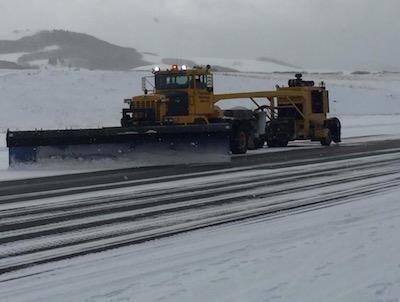Pilots Said They Did Not Know Airport Was Closed When The Accident Occurred
The NTSB has released a factual report from an accident that occurred December 23, 2015 at Telluride Regional Airport (KTEX) in Colorado in which a Hawker 400 XP jet of Mexican registration collided with a snowplow on the runway. All eight people involved, including the snowplow driver, survived the accident.

According to the report, the flight was an air taxi flight operating under part 129 that originated in Monterrey, Mexico with a planned fuel stop in El Paso, TX.
Prior to departure from Monterrey, the crew obtained preflight information, including Notice to Airmen (NOTAMs ) for the planned route of flight. The NOTAMs for KTEX noted several runway closure times; however, none of the closures were valid for the period during which the flight would arrive at KTEX.
The flight departed El Paso at 1220 MST and the flight crew discussed the weather conditions at their destination airport, including concern that the weather maybe below minimums and may not allow for a landing. The Montrose Regional Airport (KMTJ), Montrose, Colorado, was discussed as an alternate destination. As the flight neared their destination, the crew was in contact with a Denver en-route/center controller. The crew also listened to the Telluride's airport automated weather station.
At 1348, the controller asked the pilots to advise him when they had the weather and NOTAMS for KTEX, adding that another airplane just attempted an approach into KTEX, but had to execute a missed approach. The pilot reported that they received the weather information and planned to make the approach. The controller responded by giving the flight a heading, saying this would be for the descent and sequence into the airport.
At 1350, the airport operator entered a NOTAM via computer closing the runway (effective 1350) for snow removal, and the airport operator proceeded onto the runway. At 1358, the controller cleared the accident airplane for the approach to the airport. The pilot then canceled his flight plan at 1402 with the airport in sight. The crew did not change radio frequency to the airport's common traffic advisory frequency (CTAF) for traffic advisories. During the landing, the crew did not see the snowplow on the runway until it was too late to avoid a collision.

After departing El Paso, Texas, the crew was in radio contact with Air Route Traffic Control Center (ARTCC) controllers along their route of flight. After the crew changed from the Albuquerque Center controller to the Denver Center controller, the crew asked and received the latest weather for KTEX. The flight changed section controllers a couple times, before contacting the final sector controller responsible for the KTEX airport.
The controller's workload was described as heavy, working multiple air traffic arrival and departures from other airports in the sector, including Montrose and Aspen.
Prior to XA-MEX approach to KTEX, the controller was in contact with a the pilot of a Beechcraft King Air (call sign Foothills (FH) 122), who made an approach to the Telluride airport. About 1313, the controller asked FH122 to let him know when he had the weather and NOTAMs, adding that the weather was down [below minimum] at times. The pilot reported that he had the weather and NOTAMs, and the weather appeared good enough for an approach. About 1330, the controller cleared FH122 for the localizer-DME runway 9 approach to KTEX. Shortly afterwards the pilot acknowledged a handoff to the advisory frequency and said he would report landing. About 1340, the pilot (FH122) reported a missed approach to the controller. The controller advised the pilot to fly the published missed approach procedure, before working a clearance to the Montrose airport.
During a follow-up telephone conversation with the NTSB Investigator in Charge, the pilot of FH122 stated that he had talked on CTAF to a lady at the airport and the weather did not look that good. He then decided to do a missed approach before getting to the runway. After the accident, the accident airplane's cockpit voice recorder (CVR) was shipped to the vehicle recorder lab in Washington, DC for download. A CVR group was convened and the recording was auditioned by a CVR group consisting of representatives from the NTSB, FAA, Mexican Dirección General de Aeronáutica Civil (DGAC), and a technical representative from the operator. Excerpts of communications are listed in the CVR Specialist Factual Report, which is located in the official docket for this investigation.
According to a report from the Denver Post, the pilots said they were not informed by Air Traffic Control that the airport was closed when they were cleared for the approach.
The pilot sitting in the left seat held a Mexican Airline Transport License with a rating for airplane multi-engine land. The pilot held a class one medical certificate issued on July 09, 2015, with no restrictions or limitations. The pilot had 8,238 hours total flight time, with 1,412 in the accident make and model.
The pilot sitting in the right seat held a Mexican Airline Transport License with a rating for airplane multi-engine land. His class one medical certificate was issued on December 16, 2015, with no restrictions or limitations. The pilot had 7,113 hours total flight time, with 1,919 in the accident make and model.
(Images from NTSB accident docket courtesy San Miguel County Sheriff's Office)
 ANN's Daily Aero-Term (04.25.24): Airport Rotating Beacon
ANN's Daily Aero-Term (04.25.24): Airport Rotating Beacon ANN's Daily Aero-Linx (04.25.24)
ANN's Daily Aero-Linx (04.25.24) Klyde Morris (04.22.24)
Klyde Morris (04.22.24) Airborne 04.24.24: INTEGRAL E, Elixir USA, M700 RVSM
Airborne 04.24.24: INTEGRAL E, Elixir USA, M700 RVSM Airborne 04.22.24: Rotor X Worsens, Airport Fees 4 FNB?, USMC Drone Pilot
Airborne 04.22.24: Rotor X Worsens, Airport Fees 4 FNB?, USMC Drone Pilot




